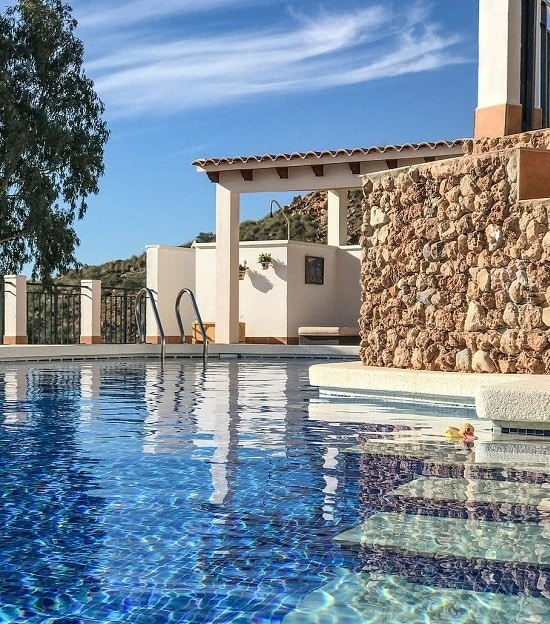Pool Clarifiers vs Flocculants: What’s the Difference?
-
Pete Ortiz
- Last updated:

Cloudy pool water is a frustrating condition made more troubling if you don’t know how it happened.
If you have been running your filter for several hours and haven’t seen any change in the clarity of your water, you might begin to wonder if there is more you can do.
There are two main chemicals you can use that will help clear up your water: clarifiers and flocculants.
We will go over each chemical and explain the similarities as well as the differences and we’ll give you some tips on which one is better, or when you should use one over the other.
Clarifiers
A pool water clarifier is a mild chemical often made from the shells of crabs and shrimp. It’s a coagulant, which means it clumps the small particles causing the cloud together. These clumped particles can then get trapped in your sand filter, and your water becomes clear. Water clarifiers are safe for all types of filters, and your pool will require no other maintenance after adding the chemical to the water.
The downside to clarifiers is that they take a long time to work, and you can be waiting several days before your water is clear again. You can swim in water treated with this chemical, but it is generally not desirable to swim in cloudy water.
- Easy to use
- Coagulant
- Milder chemical
- Safe for filter cartridges
- No vacuuming
- Takes several days
- Super Water Clarifier: Clorox Pool&Spa Swimming Pool Super Water Clarifier is a concentrated solution that clears dull, hazy, or cloudy...
- Creates Crystal Clear Pool Water: Our Swimming Pool Super Water Clarifier effectively transforms cloudy or dull pool water into...
- Easier Filtration: This product combines Small Particles for easier filtration, ensuring that even the tiniest particles are captured,...
Using Clarifiers
Here’s a step-by-step process for using clarifiers:
- Add the proper amount of chemical into your pool water as recommended on the back of the bottle. You will also need to know how much water is in your pool. (See this article for calculating the amount of water your pool holds.)
- Once you add the clarifier, you will need to wait several days for it to take effect. During this time, you will need to run your pump continuously to keep the water circulating.
- After a day or two, you can help the process along by swimming to move the water around. Vacuuming will help you remove particles that settle to the pool floor, and using an automatic skimmer will help remove clumps that float.
- Once the water clears, we recommend backwashing your filter to remove the contaminants from the system.
Flocculants
Flocculants are a type of water clarifier that uses aluminum sulfate instead of the shells of shrimp and crabs. A flocculant is an easy-to-use coagulant that attracts tiny particles and clumps them together. It works much faster than a water clarifier will, and in many cases, you can see the results in an hour or two after adding the chemical to the water.
The downside to using flocculants is that the clumps fall to the bottom of the pool and will require vacuuming to remove them. These clumps can clog your sand filter, so you will need to vacuum the debris, which means you will be draining a lot of the water out of the pool.
- Works fast
- Coagulant
- Easy to use
- Requires vacuuming
- Cannot be used with filter cartridges
- Wastes water
- In The Swim Super Floc Out swiftly clears cloudy pool water, working in hours rather than days like clarifiers.
- Our pool flocculant promotes coagulation, clumping tiny particles together, which then sink to the bottom for easy vacuuming.
- Flocculant doesn't work with cartridge filters unless you have custom plumbing for filter bypass during vacuuming.
Using Flocculants
When you use flocculants in your water, the clumped particles will fall to the pool floor. You will need to vacuum these clumps of waste to prevent them from clogging your filter. Therefore, we recommend filling your pool to its maximum capacity before adding the flocculant.
- Once the pool is at maximum capacity, you can add the proper amount of flocculant to the water as directed on the back of the bottle.
- Let the pump run for two or three hours to distribute the chemical evenly throughout the water and turn off the pump.
- Allow the pool to sit for at least 12 hours, so the chemical has time to take effect. Once 12 hours have passed, you should see clumps on your pool floor.
- To vacuum the clumps, you will need to attach your vacuum and change the multiport valve on your filter to “Waste.” As you vacuum, you remove the clumps from the pool without allowing them to enter the sand filter. You will lose water extremely rapidly while vacuuming, so you will want to work quickly.
- Once you finish vacuuming, you may need to add water. Make sure that you check and rebalance your chemicals.
Conclusion
Both of these products are water clarifiers, and they work better in different situations. We recommend starting with a water clarifier unless you need the water clear in a hurry. Clarifiers are much less work and won’t interfere with the delicate chemical balance in your pool. A clarifier will not waste water.
Flocculants are helpful if you need the pool water clear in a day and are willing to put in the work. We have also had success using flocculants after a clarifier was not able to clear up the water.
We hope that you have enjoyed reading, and we have helped clear up the difference between clarifiers and flocculants. If you have learned something new, please share this comparison on Facebook and Twitter.
Featured Image Credit: Pxfuel
Contents






